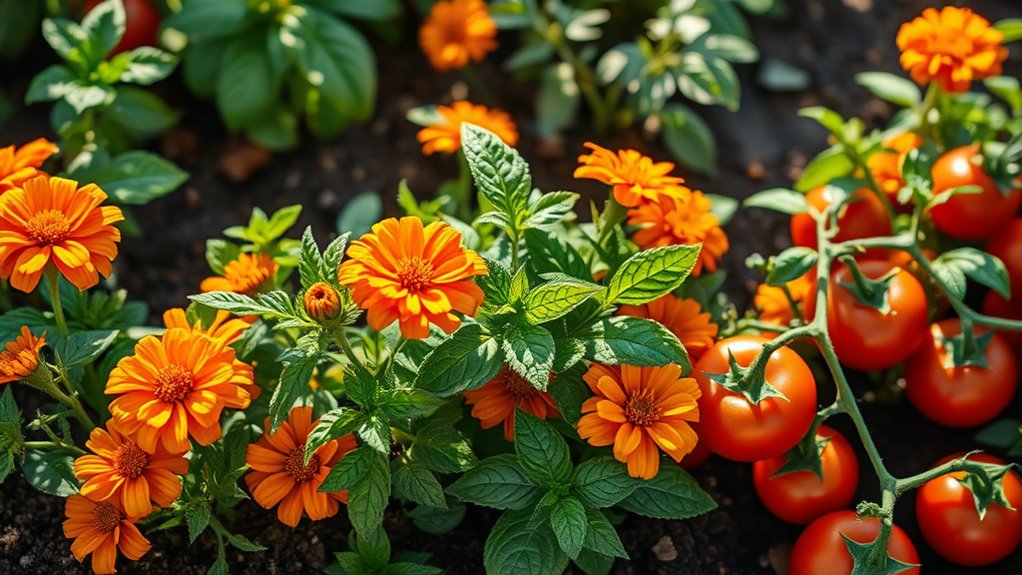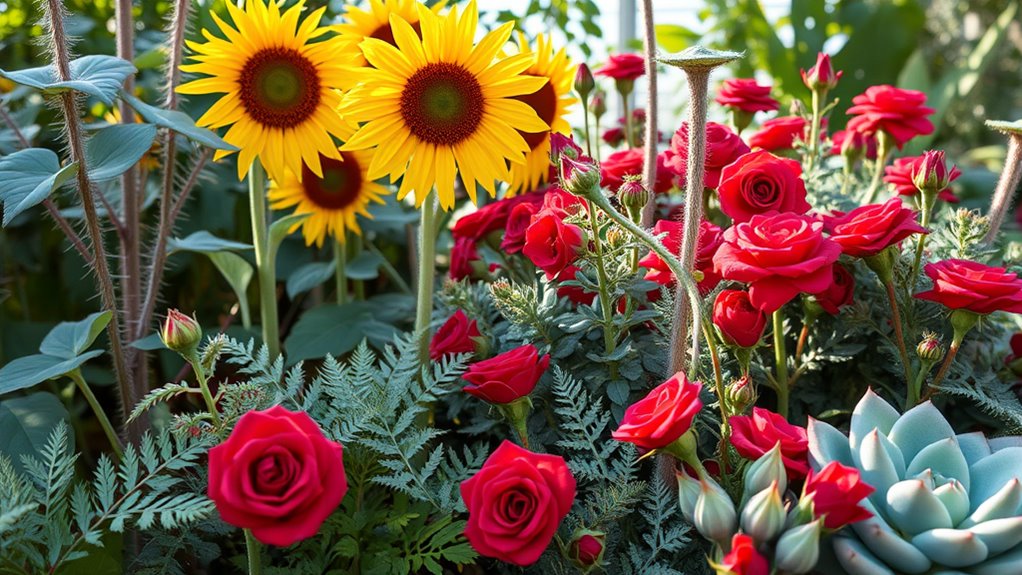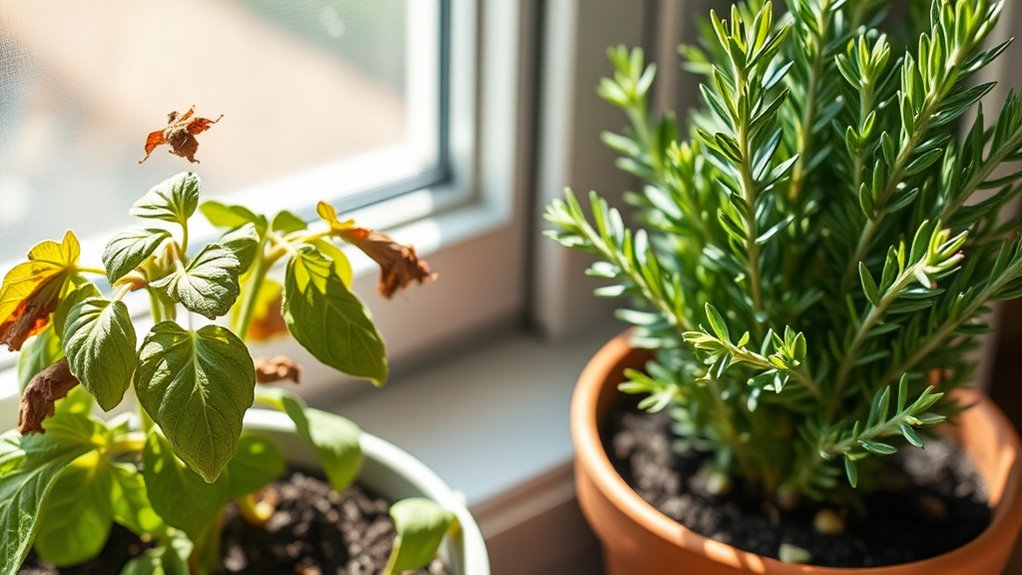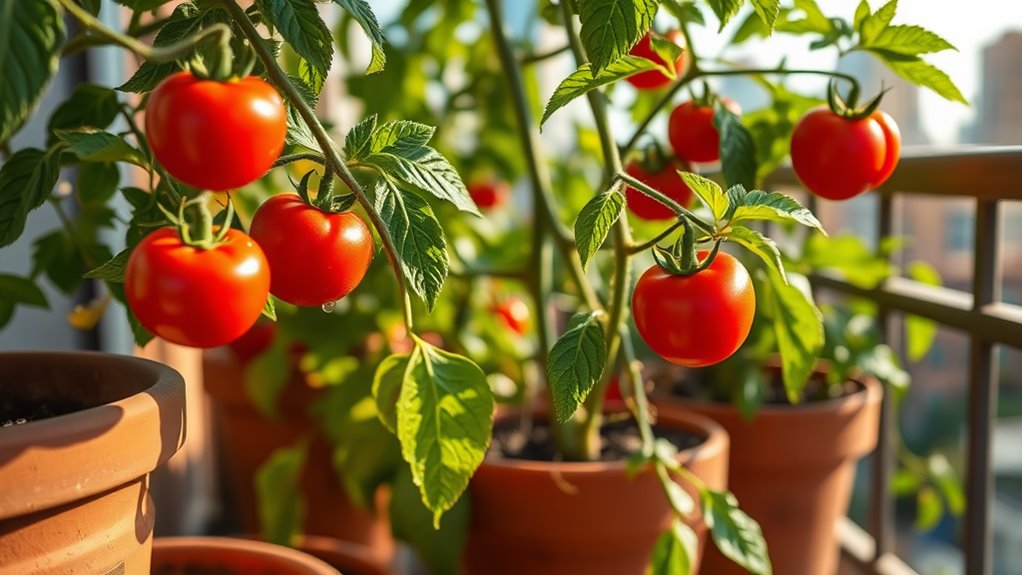These Companion Plants Will Save Your Garden This Season
You’ll maximize your garden’s potential this season by pairing beans with corn—they’ll fix nitrogen and boost growth. Add basil near tomatoes to repel pests and enhance flavor, while carrots and onions deter flies and optimize space. Marigolds will protect roots from nematodes, and radishes with cucumbers increase yields. Keep exploring these strategies for even greater garden success.
Key Takeaways
- Pair marigolds with vegetables to repel nematodes and protect roots naturally.
- Plant basil alongside tomatoes to deter aphids and enhance flavor and growth.
- Intercrop beans with corn to fix nitrogen in the soil and boost overall yields.
- Combine carrots and onions to confuse pests and maximize garden space efficiency.
- Use radishes with cucumbers to ward off beetles and improve root development.
Top Companion Plant Pairs for Vegetables
When you’re planning your vegetable garden, pairing the right plants can boost growth and deter pests effectively.
Your companion planting guide highlights top pairs like beans with corn; beans fix nitrogen, enriching soil for corn’s vigorous growth.
Pair tomatoes with basil to improve flavor and vigor through mutual shading.
Carrots thrive alongside onions, optimizing space and deterring competition from weeds.
For cucumbers, plant with radishes to enhance root development and overall yield.
These strategic combinations, detailed in a reliable companion planting guide, maximize your garden’s productivity and space efficiency.
By implementing these pairings, you can increase crop yields while promoting better overall garden resilience.
Embracing these companion planting techniques draws on scientific principles to promote healthier gardens and enhance overall plant vitality.
How Companion Plants Naturally Deter Pests
Companion plants deter pests naturally by emitting scents, chemicals, or physical barriers that disrupt insect behavior in your garden.
For instance, marigolds release potent thiophenes, repelling nematodes from your vegetable roots. Basil’s aromatic oils confuse aphids, preventing them from locating your tomatoes.
You’re planting garlic nearby? Its sulfur compounds ward off beetles effectively. Trap crops like nasturtiums lure pests away, sacrificing themselves to protect your main plants. However, to ensure success, gardeners should be aware of common mistakes when pairing plants for optimal garden health.
Moreover, the Basil and Tomato Pairing enhances growth, flavor, and pest resistance in your garden.
Boosting Yields With Effective Plant Combinations
You can boost your garden’s yields by selecting ideal plant matches that complement each other’s growth habits.
High-yield combinations let you maximize space and nutrients for optimal production.
Synergistic garden pairs enhance soil health and plant vigor, making your efforts more effective. Surprising results from my first experience have inspired novice gardeners to explore this beneficial technique.
To ensure garden success, always avoid harmful pairings that can lead to reduced plant health and lower yields.
Ideal Plant Matches
By strategically pairing plants, you’ll enhance your garden’s productivity through natural synergies that deter pests, improve soil health, and boost overall yields.
In your garden, select companions based on their complementary traits, such as nutrient sharing and pest repulsion, to create a balanced ecosystem.
-
Pair beans with corn: Beans fix nitrogen in the soil, fueling corn’s growth while stabilizing the plants.
-
Plant marigolds near tomatoes: Marigolds emit natural compounds that repel nematodes, protecting tomato roots.
-
Combine basil with peppers: Basil’s aroma confuses insects, reducing pest pressure on peppers.
-
Intercrop carrots and onions: Onions deter carrot flies, allowing both crops to thrive in shared space.
High-Yield Combinations
High-yield combinations maximize garden output by pairing plants that mutually enhance growth, such as nitrogen-fixing legumes with heavy feeders, to boost yields while minimizing resource competition.
You’ll boost your harvest by intercropping beans with corn; beans fix nitrogen that corn needs, letting you grow more in less space.
Don’t overlook pairing leafy greens like lettuce with root veggies such as carrots—they share sunlight efficiently without competing for water.
Test soil pH regularly to optimize these setups, ensuring plants thrive and deliver maximum produce with minimal inputs.
Focus on rotation to sustain soil health year-round.
Synergistic Garden Pairs
Several synergistic garden pairs can dramatically boost your garden’s yields by fostering mutual benefits, such as pest control and nutrient sharing.
These combinations leverage natural interactions to optimize space and resources.
-
Pair tomatoes with basil: You’ll repel hornworms and improve fruit flavor through basil’s aromatic oils.
-
Combine carrots and onions: Onions deter carrot flies, letting you harvest bigger, healthier roots.
-
Plant beans with corn: Beans fix nitrogen in the soil, fueling corn’s vigorous growth for higher yields.
-
Interplant marigolds among vegetables: You’ll suppress soil nematodes, protecting nearby plants and enhancing overall productivity.
Herbs That Thrive as Garden Allies
In your garden, herbs like basil and chives thrive as allies by naturally repelling pests and boosting plant health. This approach aligns with effective pest control strategies that utilize herbs as a natural alternative to chemicals.
Basil emits scents that deter aphids and flies, allowing nearby vegetables to flourish without chemical interventions.
Chives release sulfur compounds that ward off carrot rust flies and enhance soil around root crops.
Try planting mint to suppress weeds and attract beneficial insects, or rosemary to protect beans from beetles.
For best results, space herbs strategically among your plants; they improve air circulation and nutrient uptake, making your garden more resilient and productive this season.
Additionally, using everyday staples like garlic or onions can further enhance pest deterrence, supporting a thriving garden ecosystem through balanced natural defenses.
Flowers for Enhancing Soil and Plant Health
You can boost your garden’s soil health by planting nitrogen-fixing flowers like clover, which actively convert atmospheric nitrogen into a usable form for your plants. By incorporating sustainable practices, you can further support a thriving garden ecosystem through eco-friendly methods.
These blooms also improve soil structure, making it easier for roots to thrive and reducing erosion.
Now, explore soil-building flowers such as sunflowers that add organic matter as they decompose, enhancing your overall plant vitality.
For even more natural enhancement, try incorporating backyard solutions like leaves and grass clippings to further boost soil fertility.
Nitrogen-Fixing Flowers
Nitrogen-fixing flowers like clover and lupines naturally enrich your garden’s soil by converting atmospheric nitrogen into usable nutrients, boosting overall plant health and reducing the need for synthetic fertilizers.
You’ll find these plants easy to integrate, as they form symbiotic relationships with soil bacteria.
-
Select varieties: Choose clover for shady spots or lupines for sunny areas to match your garden’s conditions.
-
Plant strategically: Sow seeds in early spring alongside vegetables to maximize nitrogen benefits.
-
Monitor growth: Watch for vigorous blooms, indicating successful nitrogen fixation in your soil.
-
Harvest wisely: Cut flowers after blooming to prevent self-seeding, keeping your garden balanced.
Soil-Building Blooms
Soil-building blooms, such as marigolds and sunflowers, actively enrich your garden’s soil by suppressing pests, adding organic matter, and promoting microbial activity, which fosters healthier plant growth with less reliance on chemicals.
You can plant marigolds around vegetables to release natural compounds that deter nematodes, while sunflowers draw up nutrients, improving soil structure as they decompose.
For best results, intersperse these blooms in rotations; they’re easy to grow from seeds and thrive in full sun.
Regularly deadhead flowers to maximize organic input, boosting your soil’s fertility and resilience against diseases without synthetic aids.
This approach lets you cultivate a vibrant, sustainable garden effortlessly.
Seasonal Strategies for Companion Planting Success
Effective companion planting thrives with tailored seasonal strategies that align plant pairings to weather patterns and growth cycles.
You’ll adapt your garden by selecting companions that suit each season’s conditions, boosting yields and resilience while minimizing issues like pests or poor growth. Incorporating these strategies can help you triple your yield through proven techniques that enhance vegetable production.
-
Spring setup: Start with cool-weather plants alongside early bloomers to maximize space and deter initial pests.
-
Summer adjustments: Choose heat-resistant pairings to shade sensitive crops and enhance pollination under hotter temperatures.
-
Fall transitions: Shift to hardy combinations that extend harvests and naturally enrich soil as temperatures drop.
-
Winter preparations: Use protective cover crops with perennials to maintain soil health and prevent erosion during dormancy.
To enhance these strategies, always avoid vegetables that don’t get along in your pairings to prevent mutual growth inhibition.
Vegetable-Specific Companion Plant Recommendations
Now that you’ve mastered seasonal strategies, let’s explore tailored companions for popular vegetables to optimize your garden’s health and productivity.
For tomatoes, plant basil nearby to deter pests and enhance flavor.
Pair carrots with onions to confuse carrot flies.
Beans thrive with corn, as beans fix nitrogen that corn needs.
For peppers, add marigolds to repel nematodes.
Cucumbers benefit from radishes, which ward off cucumber beetles.
Always consider spacing and growth habits to maximize these synergies, ensuring robust yields without competition.
Test these pairings in your plot for best results.
Creating a Balanced Garden Ecosystem
While building a balanced garden ecosystem requires thoughtful planning, you’ll integrate plants, insects, and soil in a way that promotes natural harmony. This approach fosters resilience and sustainability in your garden.
-
Diversify plant species: Choose a mix of natives and perennials to create habitats that attract pollinators and deter pests naturally.
-
Foster beneficial insects: Plant flowers like marigolds to lure ladybugs and bees, enhancing pollination and biological control.
-
Optimize soil management: Test and amend soil pH and nutrients using organic compost, ensuring it supports microbial life for better plant health.
-
Monitor interactions: Track plant-insect dynamics weekly, adjusting watering and spacing to maintain equilibrium without chemicals.
Innovative Ways to Pair Plants for Maximum Benefits
Pairing plants creatively boosts your garden’s productivity and health by leveraging their natural synergies.
You interplant nitrogen-fixing beans with corn to enrich soil while providing support, or place basil near tomatoes to repel insects and enhance flavors.
Experiment with polyculture beds, mixing herbs like chives with roses to deter aphids naturally.
Monitor growth patterns and adjust pairings based on your climate; this technique optimizes space, reduces diseases, and boosts yields.
Track results with simple notes to refine strategies each season, ensuring a thriving, sustainable ecosystem.





